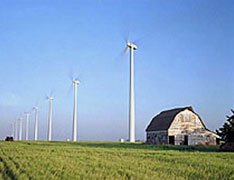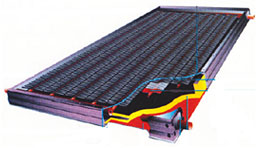Tankless or On-demand Water Heaters
Tankless, or on-demand, water heaters supply hot water without having to maintain a reservoir of water at high temperature 24 hours a day. This concept has been compared to leaving your car running all day in case you need to go to the store later. 1
These small units sense when water is being drawn and feed it through a copper heat exchanger, raising its temperature by approximately 50°F at a rate of up to 5 gpm. Copper is the best material for use in these units because of its high thermal conductivity. Although such heaters have been popular and widely used in Europe and Japan, their popularity in North America is growing rapidly, as consumers look to save on energy and water.
Applications
Tankless systems can serve practically any hot water need, ranging from meeting a whole building's needs to boosting the temperature of a passive solar heating system. They are used extensively in household applications, as well as in commercial buildings, such as the Chipotle Mexican Grill restaurant franchise, which is participating in the LEED for Retail pilot project. The franchise is applying what they called "accidental sustainability" or design driven by purely rational choices, rather than any kind of green program. The LEED and green building support programs are seen simply as a bonus to their existing practices. And the benefits from the use of this system are twofold: substantial economic savings and smaller environmental impact. 2
The units boost the temperature of incoming water and can be installed in series to build up water temperature. Some manufacturers offer single units which run water through three stages, increasing the temperature at each stage and, in turn, increasing water flow capacity at any given temperature. This allows their use to be scaled up to meet practically any building's water needs. Raising water temperature also provides opportunities to incorporate the units into staged solar water heaters, providing a consistent supply of hot water.
Benefits
The U.S. Department of Energy says energy savings can be as high as 34% for low water use households and between 8% and 14% for heavy users. 3 These savings are particularly valuable, given that water heating accounts for approximately 14% of the average U.S. household's energy use. 4
Wind Energy
Today, with rising oil prices, declining supply and a sincere desire to find more sustainable sources of power, wind energy has never been more popular. Giant turbine wind farms and individual micropower generation units are becoming more common, as more people seek to offset climate change impacts.
 Horse Hollow Wind Energy Center in Texas-the world's largest wind farm.
Horse Hollow Wind Energy Center in Texas-the world's largest wind farm. Photo courtesy of www.leonardo-energy.org
Capacity
Growth can be seen all over the world, with capacity going from less than 4,000 MW in the mid-1990s to more than 70,000 MW today. 5 This growth is driven by two factors: improved technology leading to lower implementation and operating costs (dropping from more than 30 cents per kWh to 3-6 cents in the last ten years); and, a greater acceptance of the potential for wind energy to address domestic energy needs. 6
The world's largest wind energy project is Horse Hollow Wind Energy Center in Texas. According to its operator, FPL Energy, each of this center's 400 turbines can provide enough electricity for approximately 300 homes. FPL estimates that, relative to standard power production, their 65 wind farms in 16 states and Canada have saved nearly 9 million tons of carbon dioxide, 21,000 tons of sulfur dioxide and 13,000 tons of nitrogen oxide. 7 FPL says wind turbines throughout the USA generated nearly 17 billion kWh in 2007, enough to serve 4.5 million households. 8
 A number of farms have installed turbines as a means of diversifying income.
A number of farms have installed turbines as a means of diversifying income. Photo courtesy of U.S. Department of Energy
On a smaller scale, a number of farmers, schools and individual homeowners have installed either single or multiple turbines on their property either to meet their own power needs or to feed into the power grid. Small-scale wind turbines can cost between $3,000 and $50,000 to install.
However, depending on a variety of factors such as government incentives, local wind speeds and cost savings related to reduced demand on your local utility, payback can be as short as six years.
Copper's Role
Copper is important to the operation, efficiency and protection of the system. It grounds the towers in the event of lightning, transports electricity to substations and connects the system into the utility grid. Copper also plays a critical role in the turbine motors and their control wires. 9
Government Programs
EPA's Green Purchasing Challenge encourages colleges and universities, Fortune 500 companies and local, state and federal government operations to double the percentage of their energy that comes from renewable sources, including wind power. 10 The Department of Energy has a program to support schools in installing turbines on their property. Check with local utilities for other federal and state government incentives that may be available.
Solar Collectors
 Cutaway section of a glazed flat-plate collector, which is often seen as striking a balance between the simple unglazed system and an advanced evacuated-tube system.
Cutaway section of a glazed flat-plate collector, which is often seen as striking a balance between the simple unglazed system and an advanced evacuated-tube system.The average homeowner and many industries spend a significant portion of their energy costs on heating water. One way to minimize those costs is to use the sun to heat, or supplement the energy required for heating, water. There are a number of technologies that can accomplish this, depending on average sunlight, annual temperature variation and acceptable payback periods. One popular option is the solar collector. Households can use this technology for everything from providing for all of their hot water to simply heating their pools. Businesses, including those in the hospitality, agriculture and aquaculture industries, also have adopted this technology.
How they work
The most common solar collectors are glazed or unglazed flat-plate panels and evacuated tubes panels. Their basic elements include a copper absorber plate and copper tubing to route the water through the system. Copper is used because of its durability and thermal conductivity. In practice, the heat generated by the sun passes through the glazing, heats the copper absorber plate, which then heats the water in the riser tubes drawn from the cold water intake at the bottom of the unit, and is then fed out the top directly into an application or into a secondary heater to step-up its temperature. These self-contained collectors can be mounted on any sunny surface, usually a roof, and are aesthetically subtle, often being confused for skylights.
Costs and Incentives
Glazed flat-plate systems start at around $2,400 and can go up from there, depending on the output levels and temperatures needed. The units are relatively maintenance-free and estimated to last 20-plus years. Payback periods vary greatly, but energy savings for a family of four can be as high as 38% per month. Incentive programs allow users to realize savings immediately. To learn more about the availability of these programs, or for more information, in the United States contact the National Database of State Incentives for Renewable Energy and the U.S. Department of Energy's EERE program. In Canada, contact the Renewable Energy Deployment Initiative office and Natural Resources Canada.
|
Energy & Atmosphere On-site renewable energy |
1, 2 or 3 points can be achieved in this credit area for buildings that use renewable energy systems to produce 2.5%, 7.5% or 12.5% of the building's energy (as a percentage of annual energy cost). Renewable systems mentioned in LEED include solar, wind, geothermal, low-impact hydro, biomass and biogas. |
Footnotes
-
 Eemax Tankless Electric Water Heaters Employee, March 2007
Eemax Tankless Electric Water Heaters Employee, March 2007 -
 AustinEnergy.com, "Energy Efficiency - Case Study: Chipotle Mexican Grill"
AustinEnergy.com, "Energy Efficiency - Case Study: Chipotle Mexican Grill" -
 U.S. Department of Energy, "A Consumer's Guide: Demand (Tankless) Water Heaters"
U.S. Department of Energy, "A Consumer's Guide: Demand (Tankless) Water Heaters" -
 U.S Department of Energy, "A Consumer's Guide: Demand (Tankless) Water Heaters"
U.S Department of Energy, "A Consumer's Guide: Demand (Tankless) Water Heaters" -
 Flowers, Larry. "Wind Energy Update", National Renewable Energy Laboratory
Flowers, Larry. "Wind Energy Update", National Renewable Energy Laboratory -
 FPL Energy, LLC, "Economics of Wind Energy"
FPL Energy, LLC, "Economics of Wind Energy" -
 FPL Energy, LLC, "Facts"
FPL Energy, LLC, "Facts" -
 FPL Energy, LLC, "Facts at a glance"
FPL Energy, LLC, "Facts at a glance" -
 Copper Development Association, "Copper and Wind Energy: Partners For a Clean Environment"
Copper Development Association, "Copper and Wind Energy: Partners For a Clean Environment" -
 Copper Development Association, "Copper and Wind Energy: Partners For a Clean Environment"
Copper Development Association, "Copper and Wind Energy: Partners For a Clean Environment" -
 FPL Energy, LLC, "Economics of Wind Energy"
FPL Energy, LLC, "Economics of Wind Energy"

 A tankless hot water system
A tankless hot water system